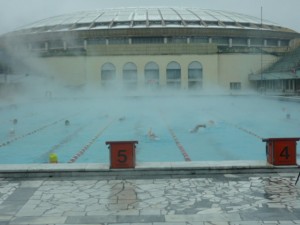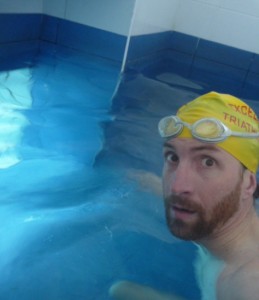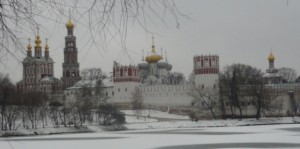Dec. 29 – Budapest, Hungary
I came to Budapest for the water, but I was not the only one. The city is famous for the many thermal springs which attracted first Romans and Turks, then Hungarians, and now tourists.
Prepaid ticket in hand, I approached the magnificent 98 year-old Szechenyi Bath in the city’s  central park. It is a venerable institution in Budapest – the Maracana Stadium of bathing, one of the world’s biggest spa complexes. And unfortunately, like the Maracana for a Brazil futebol match, it was packed. The anteroom, all columns, domes, mosaics and statues, resounded with confused foreigners trying to get in and resigned cashiers and gatekeepers explaining that there were insufficient lockers to accommodate the Holiday crowd.
central park. It is a venerable institution in Budapest – the Maracana Stadium of bathing, one of the world’s biggest spa complexes. And unfortunately, like the Maracana for a Brazil futebol match, it was packed. The anteroom, all columns, domes, mosaics and statues, resounded with confused foreigners trying to get in and resigned cashiers and gatekeepers explaining that there were insufficient lockers to accommodate the Holiday crowd.
After an enjoyment-sapping long time, I finally got a locker key and headed into the men’s change area. In my swim trunks, and clutching a towel, cap and goggles, I ventured to the outdoor pools. There was enough uncertainty involved in this process – wandering semi-naked through areas where most people were fully clothed – to discourage me from looking for the smaller hot pools.
In any case I was interested in actual swimming and the main pool offered that. Swim caps were mandatory, a rule rigorously enforced by vigilant whistle-blowing monitors. “Ah bon” I heard more than once after a guard gave a stern hand-to-head gesture “il faut avoir un bonnet.” I did my lengths guided by underwater lights. Around me, a variety of figures moved through the water, some stately and ponderous, some twitchy-limbed. I would pause, cold air embracing my exposed shoulders, and look at the dark night sky. Contemplating the pale yellow glow of the graceful building, it seemed amazing to me a century ago, a monarchy had produced such a lavish structure for public recreation.
Workout done, I moved into one of the hot pools that flanked the main pool. Dozens of  bathers lolled in the steaming water, an enormous natural jacuzzi. Excited tourist families, embracing couples, matronly ladies chatting. Geysers bubbled and frothed from the bottom, and bathers improvised an astonishingly strong whirlpool. I had noticed a sulfurous smell earlier, but no longer. I looked around me at relaxed, happy people, and thought “hot water is civilization.”
bathers lolled in the steaming water, an enormous natural jacuzzi. Excited tourist families, embracing couples, matronly ladies chatting. Geysers bubbled and frothed from the bottom, and bathers improvised an astonishingly strong whirlpool. I had noticed a sulfurous smell earlier, but no longer. I looked around me at relaxed, happy people, and thought “hot water is civilization.”



